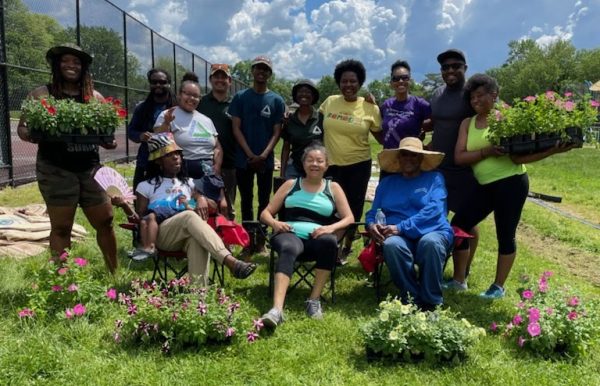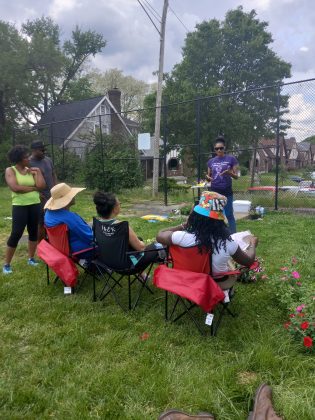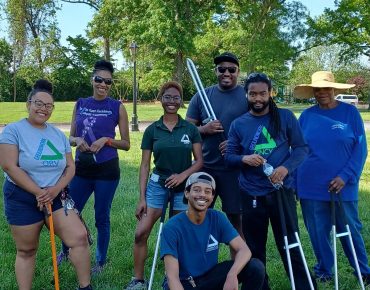
Amid unprecedented floods, record-breaking heat waves, and devastating fires, grassroots organizations across the country are taking action to alleviate the impact of the climate crisis. A long history of discrimination left Cincinnati’s lower-income communities and neighborhoods with primarily Black populations unable to withstand the changing climate. As part of the Climate Safe Neighborhoods initiative, Groundwork Ohio River Valley and local partner organizations have established Climate Advisory Groups to enable residents to discuss community needs, learn new skills, develop resiliency plans to combat environmental injustices, and promote green infrastructure in Cincinnati.
Groundwork Ohio River Valley’s Community and Climate Programs Lead, Kelsey Hawkins-Johnson, and the Co-Executive Director, Alan Edwards, spoke with me about their green infrastructure initiatives and how the team is collaborating with residents to take climate action while creating opportunities for community leadership and resilience.
- Groundwork ORV has been tackling climate issues for several years. Can you tell me a little about how climate change impacts Cincinnati and how you all are working to increase climate resiliency?
- Kelsey: In Cincinnati, we’re seeing various climate change impacts like flooding, pollution, landslides, and urban heat islands. The stormwater infrastructure here is not great, especially in environmental justice communities – communities that are disproportionately exposed to many environmental hazards and climate change risk factors. Flooding and landslides are huge issues with the lack of green space and infrastructure. The contribution of waste sites and industrial areas also adds to air pollution.
- Alan: As part of the Climate Safe Neighborhoods partnership, we’re building Climate Advisory Groups to get residents involved through survey work and mapping to create an equitable climate resiliency plan ranging from green infrastructure projects to air monitoring initiatives and water protection efforts. Unfortunately, there is no redlining map for Cincinnati even though it happened, which has complicated the mapping process and required more work on the front end to identify the areas that need attention.

- As part of the CSN partnership, GW ORV prioritizes climate mitigation and solutions for residents in various ways. How are you working with residents to identify and prioritize needs, and what issues are the top concern for communities?
- Kelsey: As part of Climate Safe Neighborhoods, we organize climate advisory groups for residents in environmental justice communities. They do survey work and mapping activities in workbooks to identify and map out where concerns or assets are in the community. The survey work enables residents to connect with their neighbors to discuss environmental issues and solutions. There’s a huge educational component to our programs which teaches residents about redlining and what climate change is. The group also gives residents agency and the ability to design neighborhood climate resiliency maps as a call to action.
- Alan: Everything is tied together through the Climate Safe Neighborhoods partnership, it’s the thread that weaves all of our programs together, and we’re focusing on citizen science with residents, Green Team youth, and Green Corps members. The concerns from residents encompass climate and infrastructure issues but stem from a deeper systemic level – addressing how to take action to mitigate the impacts of climate change, neighborhood and housing infrastructure, and resource allocation.
- In order to tackle some of the different climate change impacts like flooding and landslides, are there green infrastructure projects you’re currently working on? If so, why are the projects important?
- Kelsey: There are ongoing green infrastructure projects in neighborhoods with urban heat and flooding

Clean up day at the Bond Hill neighborhood. issues. Community Advisory Groups from Lower Price Hill, Roselawn & Bond Hill, and Beekman Corridor developed resiliency plans to address climate disasters, and tree planting was a common solution. In Lower Price Hill, Ohio’s first Climate Safe Neighborhood and a small, tight-knit community with an industrial legacy, we’re planting around 60 plus trees along the streets. One community organizer applied for a tree planting grant on public property for the Roselawn & Bond Hill neighborhoods, a predominantly Black community with disproportionate exposure to industrial pollution. In the Beekman Corridor, an area with high poverty rates and communities of color, we are working to provide trees to address flooding and heat and support planting with our Green Corps.
- Alan: The ongoing projects epitomize our approach to climate resiliency and environmental justice work. We’re going directly to the communities, engaging with them, compensating them for their time, and bringing them results. One unique thing we’re doing is connecting with partners who can address some of the issues raised and drafted in the resiliency plans. For example, one of our partners is donating trees in-line with the Lower Price Hill resiliency plan. This has allowed us to prioritize tree planting in the neighborhoods where residents want it. In Lower Price Hill, we’re building a green roof, a green stormwater infrastructure project we’ve worked on with Cincinnati Public Schools and the Metropolitan Sewer District for the last ten to 20 years. At the start, as the school buildings were being redeveloped, we thought we would cut back on the water being dumped into the combined stormwater system by installing green infrastructure. The school devised plans and moved forward, but unfortunately, the money ran out. Later, The Climate Advisory Group in Lower Price Hill identified this ready-to-go project as a potential opportunity, and it is now in progress.
- Kelsey: There are ongoing green infrastructure projects in neighborhoods with urban heat and flooding
- The effects of climate action vary among communities and places. Have the green infrastructure projects had any immediate, tangible, or intangible impacts on the environment or communities? What do you envision for the long-term impact of these projects?
- Alan: The main thrust of our work is engagement and action in environmental justice communities. Our goal for the long term is to empower the residents, advisory group participants, and the broader communities to realize their potential to disrupt and change the system that’s traditionally built to exclude people.
- Kelsey: We’re seeing more community involvement in climate science research, leadership, and resilience that continues to grow and strengthen. Youth from the Green Team and the Green Corps have joined advisory groups, regularly participate in training sessions, and will participate in the implementation of green infrastructure projects. Some community leaders have joined as Groundwork staff, and residents from past advisory groups are on the equity committee for the Green Cincinnati Plan – a comprehensive plan led by a steering committee to advance the sustainability, equity, and resilience of Cincinnati. We work with communities that have historically been disinvested and harmed by redlining and other oppressive systems; having them lead the journey to address the historic and ongoing environmental harms in their community is essential. The long-term impact of cultivating community leadership is revolutionary for residents, the community, and the neighborhoods they live in. Our goal is to recreate Climate Advisory Groups in other neighborhoods so that we can continue to bring data, make connections and build resident capacity in Cincinnati’s communities. The climate advisory groups create belonging and professional opportunities for folks to share their voices and thoughts, hold the city accountable, and push for equitable resource distribution to meet more of their needs.
Alan Edwards is the co-executive director, and Kelsey Hawkins-Johnson is the community and climate programs lead at Groundwork Ohio River Valley. You can learn more about Groundwork ORV and their Climate Safe Neighborhoods programs here.
